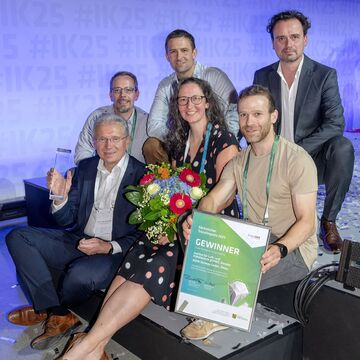
Winner of the Saxon State Prize for Transfer – Spin-off Category 2025
The ILK Dresden and AQVA Synergy GmbH have won the Saxon State Prize in the field of transfer/spin-offs!

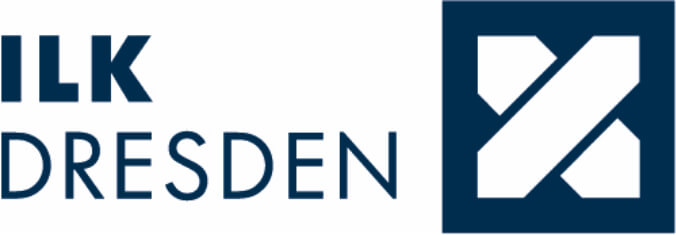

The ILK Dresden and AQVA Synergy GmbH have won the Saxon State Prize in the field of transfer/spin-offs!

This year, our scientists and engineers were able to demonstrate their expertise in two major research projects.

The anniversary celebration of the ILK Dresden

60 years of industry-related cutting-edge research (1964 - 2024)

Minister President Michael Kretschmer emphasises: "Germany's most important resource sits between our ears."

Former ILK Institute Director Dr. Ralf Herzog receives the MEMBER of HONOUR award from the International Institute of Refrigeration (IIR).

Visitors to the Dresden Long Night of Science were magically drawn to the ILK Dresden this year, as our scientists created a special highlight - real snow!

The prestigious prize is awarded every two years to recognize an outstanding partnership project that improves the environment through novel and creative approaches.

On August 18, 2022, the time has come. The foundation of the first start-up of the ILK Dresden is notarized and entered in the commercial register.

The 2.5 meter high thermometer on the façade of the ILK Dresden is inaugurated together with the head of Dresden's economic development department, the students of the Kreuzgymnasium and all employees.

"Excellence from zero Kelvin" - self-confident, young & transparent - the new external image of the ILK Dresden

At its meeting on 26.11.2019, the Board of the Verein zur Förderung der Luft- und Kältetechnik e.V., as the sole shareholder of the ILK, passed the baton of sole management of the ILK from Dr. rer. nat. habil. Ralf Herzog to Prof. Dr.-Ing. Uwe Franzke.

KETEC is an innovative platform for research and development as well as education, which has the potential to find new solutions to the current challenges of the energy transition and thus further strengthen Saxony's and Germany's innovative power in the sector.
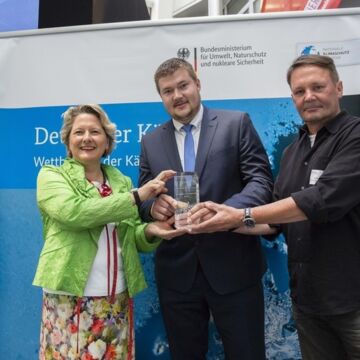
The Federal Ministry for the Environment, Nature Conservation and Nuclear Safety (BMU) has awarded the German Refrigeration Prize for the sixth time.
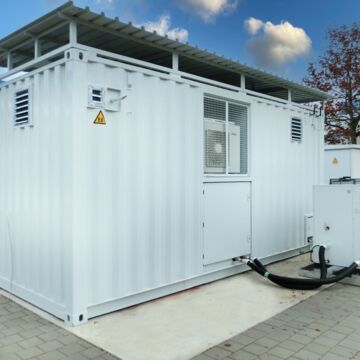
Natural refrigerants have long been the focus of ILK Dresden's scientific work. In 2018, the institute developed and built the first performance test bench for semi-hermetic propane compressors.

With effect from January 1, 2018, Prof. Dr.-Ing. Uwe Franzke took over the position of Managing Director at the ILK Dresden and, together with Dr. rer. nat. habil. Ralf Herzog to manage the company.

The ILK Dresden is host and organizer of the two-day IIR International Workshop “Cold Applications in Life Sciences”, a scientific forum of experts in cryobiology and cryomedicine.

Environment Minister Barbara Hendricks presented the 10,000 euro prize for the best innovation to ILK project manager Marcus Honke on April 11, 2016.

On September 22, 2015, the ILK Dresden is hosting the 10th Air Pollution Control Colloquium on the topic of “Air pollution control - a complex challenge”.

Shortly after the founding of the SIG in Saxony, the joining of forces also takes place at a national level. On April 30, 2014, the German Industrial Research Association KONRAD ZUSE e.V. is founded in Berlin. The ILK Dresden is one of the 66 founding members.

The SIG was founded in April 2014 to pool the strengths of the industrial research institutes in Saxony - with more than 950 employees. With around 150 employees, the ILK Dresden is one of the largest institutes of the 18 founding members.

The 12th IIR Conference CRYOGENICS 2012 took place for the first time in Germany, in Dresden, from September 11-14, 2012. Together with partners from the Czech Republic, the ILK Dresden organized and scientifically designed this international IIR conference on cryogenics and low-temperature physics.

On December 17, 2010, the ILK Dresden celebrates its 20th anniversary as a non-profit research company. The ILK Dresden has now been working as an independent company with around 130 employees on the national and international market for 20 years.

As part of an accreditation procedure in accordance with DIN EN ISO/IEC 17025, the ILK Dresden testing laboratory was officially awarded this competence.

On July 4, 2008, the ILK Dresden held its first ILK Dresden Family Day directly at the ILK Dresden. ILK Dresden employees and their families were invited to a social afternoon at the ILK Dresden.

In January 2008, the ILK Dresden receives its first research project for a vacuum ice store for ice production using direct evaporation with water and a mechanical compressor.

The ILK Dresden has been working on various development tasks at the international research center CERN in Geneva since April 1997 and is involved in the construction of the new accelerator LHC (Large Hadron Collider) and its detectors.

The ILK Dresden is installing a demonstration and test facility for solar thermal air conditioning in and on the ILK test field.

In addition to thermal factors, the thermal comfort of rooms also depends on the air quality. In the Federal Chancellor's office, the quality of the ventilation was measured using volume flow measurements and the distribution of air in the room was assessed using tracer gas.

When the Gläserne Manufaktur was commissioned, its core business was the production of the "Phaeton' - a luxury-class saloon. High demands were placed on the architecture and technology, as the factory is located right in the center of Dresden.

Dr. Herzog continues to manage the company and grants Dr. Franzke power of attorney. Franzke becomes a member of the management.

The German pavilion was cooled with R718 turbo chillers - developed and installed on site by the ILK Dresden.

The "BIG 5 SHOW" is one of the largest trade fairs in the United Arab Emirates. In 1999, the ILK Dresden presented its solar refrigerated container there and met with great interest.

The ILK Dresden, together with the University Hospital “Carl-Gustav-Carus” of the TU Dresden, is hosting the first Dresden Colloquium with the topic “Application of low temperatures in medicine”.

As early as 1995, 32 PV modules were installed at the ILK Dresden as a façade system with 7 kWp for research purposes - the largest system in Dresden at the time.

Basic research and applied research go hand in hand

"Water as a refrigerant for large refrigeration systems and heat pumps" was the topic of the first Dresden Colloquium on Refrigeration Technology back in 1994. The event took place in the institute's main building.

The editors of the trade journals "Luft- und Kältetechnik" and "Ki Klima Kälte Heizung", Professor Heinrich and Professor Steimle, merged the two journals to form the new journal "Ki Luft- und Kältetechnik" as of January 1, 1994.

Together with the VDI, the ILK Dresden organized its first colloquium on air pollution control. The topic of this event day in the Dresden Blockhaus was "Filtering separators".

The institute achieves an annual turnover of DM 13.8 million. The main building is to be renovated and extended. The construction of a new test hall is also planned.

The Verein zur Förderung der Luft- und Kältetechnik e.V. buys the institute from the Treuhandanstalt Berlin for one German mark on April 23, 1993.

The new logo was designed by Rolf Roeder. It symbolizes two intersecting streams of fabric or energy in the colors green and blue. In 1996, the registration of the trademark is confirmed by the German Patent Office.

"If this valuable institution were to be lost in the context of German unification or were to disintegrate into individual parts, it would be an irreparable loss for the whole of Germany." Prof. Fritz Steimle from Essen in May 1990 on the continued existence of the ILK Dresden

Water is the oldest known refrigerant. It is used in a variety of ways in absorption refrigeration systems and in steam jet rotary systems. Research and development work on the use of water as a refrigerant in compression chillers began at the ILK Dresden in 1991.

Professor Heinrich's willingness to take over the management of the institute he had established in 1964 was a decisive step towards privatization.

The Kombinate disintegrate. The Treuhand Act comes into force. Windows 3.0 from Microsoft conquers the market. Germany celebrates reunification. Professor Heinrich returns to the ILK Dresden.

At the end of October 1989, the Combine management acknowledged fundamental problems such as supply shortages, discontinuity in production, egalitarianism in wage policy instead of applying the performance principle, and difficulties with business trips to Western countries.

…

Many innovative ideas of ILK Dresden were used in the reconstruction of the Dresden Semperoper in the 1980s.

Mandatory subordination to parent company cuts the institute's independence - Institute Director Heinrich leaves the ILK Dresden and is appointed to the TU Dresden
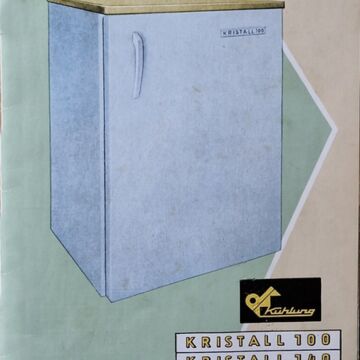
GDR refrigerators too good for Quelle
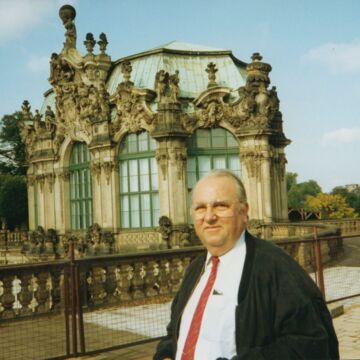
Professor Fritz Steimle headed the Institute for Applied Thermodynamics and Air Conditioning Technology at the University of Essen for over 30 years. In 1990, he became the most important and recognized advocate for the preservation and continued existence of the ILK Dresden.

The Ex-Bau was to become one of the most modern buildings of its time in terms of energy efficiency.
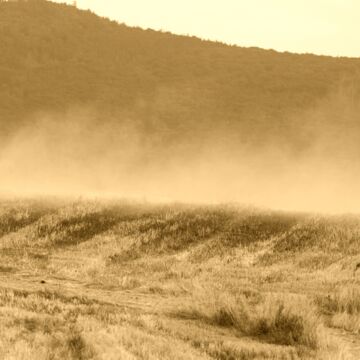
Developments for the textile industry, among others Separation and filter technology are in focus

Good, effective stable ventilation is an important factor in keeping livestock. In the 1970s/80s, the institute developed patented stable ventilation systems for agriculture.
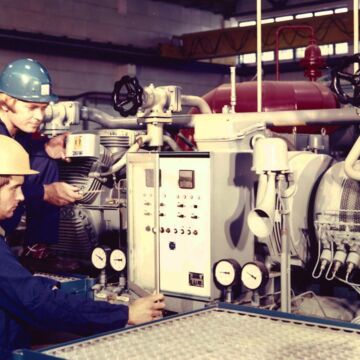
The tasks of the 433 employees in the individual departments of the institute

GDR becomes a member of the IIR and ILK Dresden takes over the tasks of the National Committee

ILK Dresden was responsible for the scientific and technical development of a total of 17 combine operations. The most important task was the development of the so-called "ILKA system".

The GDR's energy policy was geared towards minimizing the use of primary energy. Many new heat pump prototypes and experimental buildings were built as a preliminary stage to the widespread use of heat pumps planned by the Council of Ministers in 1981.

The institute is subordinated to the VEB Kombinat Luft- und Kältetechnik (ILKA).
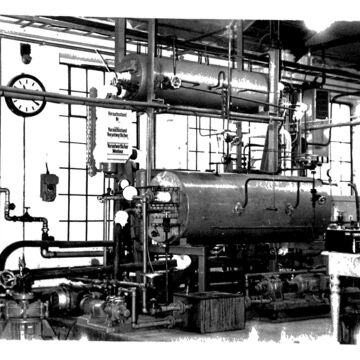
As early as 1966, the range of development and research at the ILK Dresden was broad and characterized by the most diverse requirements of the companies and industry of the time. Some technical reports from this period have been preserved in the institute's archive:

Plank is regarded as the founder of scientific refrigeration technology and is often referred to as the "refrigeration pope".

Even then, Institute Director Professor Heinrich paid particular attention to the use of modern computing technology.

In 1966, Werner Herrmann, a graduate designer, created a graphic design to cultivate a modest identity for the institute.

In the early years, the institute grew by recruiting a large number of graduates from universities and technical colleges, in particular from the TU Dresden and the Freiberg Mining Academy. By the end of the 1960s, ILK Dresden employed around 400 people.

On July 1, 1964, the appointment contract dated February 20, 1964 was signed between Dr.-Ing. Günter Heinrich, until then Technical Director at DKK Scharfenstein, and VVB Air and Cooling Technology as Director of ILK Dresden.

The journal Luft- und Kältetechnik was founded in 1964 by Dr. Günter Heinrich to publish the scientific findings of ILK Dresden, but also as a publication medium for ventilation and refrigeration technology and all related specialist areas.

ILK Dresden was only able to cope with the growth in test areas and the increasing number of employees with numerous external and branch offices.

The new center in Dresden will have 184 positions (105 in Dresden and 79 in Merseburg).

Mansfelder Straße 26 corresponds to today's postal address Bertolt-Brecht-Allee 20. The building formerly housed the State Employment Office and later became the headquarters of the Institute for Chemical and Refrigeration Equipment.

The pace of development of chemical plant construction in the GDR can no longer keep up with economic needs. The consequences?